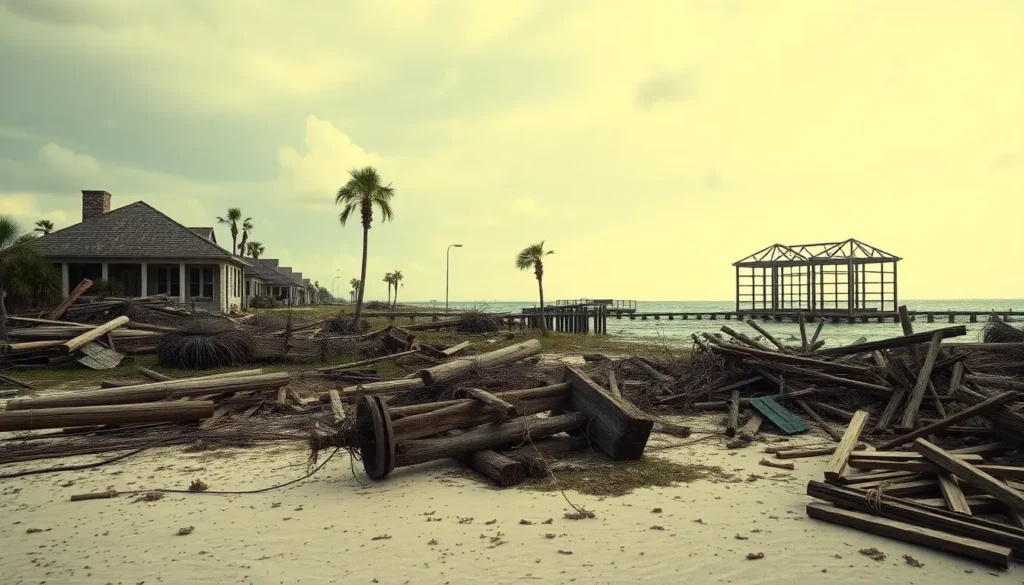Hurricane Michael made quite the entrance in 2018, leaving a trail of chaos and confusion in its wake. If you think hurricanes are just nature’s way of throwing a tantrum, Michael was the ultimate drama queen, demanding attention with its powerful winds and torrential rains. But what category was this storm? Spoiler alert: it wasn’t just another mild breeze.
As the storm barreled through the Gulf Coast, it quickly escalated to a Category 5 hurricane, packing winds that could make even the toughest palm trees reconsider their life choices. Understanding the category of Hurricane Michael not only highlights its ferocity but also underscores the importance of preparedness when Mother Nature decides to unleash her fury. Buckle up as we dive into the details of this tempestuous event and what it means for future storms.
Table of Contents
ToggleOverview of Hurricane Michael
Hurricane Michael formed in October 2018 and intensified rapidly. It reached Category 5 status, with maximum sustained winds of 160 miles per hour. This level of intensity positioned Michael among the strongest hurricanes to ever impact the Florida Panhandle.
Destruction accompanied the hurricane’s landfall near Mexico Beach, Florida, on October 10. The storm surge measured over 14 feet, leading to significant damage to homes, infrastructure, and coastal areas. Reports confirmed that over 20 lives were lost due to Michael’s devastating effects.
The aftermath revealed extensive flooding, downed trees, and power outages affecting millions. It took weeks for many communities to restore basic services—some areas experienced disruptions lasting for months. Emergency response teams mobilized quickly to aid recovery efforts following the storm.
Diverse categories within the Saffir-Simpson Hurricane Wind Scale help classify hurricanes based on wind speed. Understanding these categories proves essential for both preparedness and risk assessment. Awareness of hurricane categories allows individuals and communities to take appropriate precautions.
Michael’s legacy includes highlighting vulnerabilities in infrastructure and emergency preparedness. Communities began reevaluating their resilience strategies as a direct response to the storm. Enhanced building codes and improved evacuation plans emerged from lessons learned during this disaster. Experts emphasized the ongoing need for comprehensive approaches to hurricane preparedness, considering changing climate conditions.
Classification of Hurricanes

Understanding hurricane classification is essential for assessing their potential impact. The Saffir-Simpson Hurricane Wind Scale categorizes hurricanes from 1 to 5 based on wind speeds, which helps in preparing for storms like Hurricane Michael.
Saffir-Simpson Hurricane Wind Scale
The Saffir-Simpson Hurricane Wind Scale ranks hurricanes according to wind gust intensity. Category 1 storms feature winds between 74 and 95 miles per hour, causing minimal damage. Category 2 hurricanes, with winds from 96 to 110 miles per hour, can inflict considerable damage. Categories 3 and 4 indicate major hurricanes; winds of 111 to 129 miles per hour and 130 to 156 miles per hour result in devastating impacts. A Category 5 hurricane, like Michael, boasts winds exceeding 157 miles per hour, resulting in catastrophic destruction. This scale provides insight into potential risks associated with each category.
Categories Explained
Hurricane categories detail the expected destruction and hazards associated with storms. Category 1 signifies some damage, mainly to unanchored mobile homes and trees. Category 2 often leads to significant damage, particularly in older homes. When examining Category 3 hurricanes, one notices severe damage to roofs and walls. Category 4 storms can lead to catastrophic structural damage, displacing many people. The Category 5 designation indicates complete destruction of building structures, emphasizing the lethal power of winds over 157 miles per hour. Michael exemplified the need for preparedness and response strategies to mitigate the effects of such severe weather.
Hurricane Michael’s Impact
Hurricane Michael left a lasting mark on the areas it struck. The storm’s destructive force primarily stemmed from its wind speeds and extensive damage it caused.
Wind Speeds and Damage
Maximum sustained winds reached 160 miles per hour, qualifying Hurricane Michael as a Category 5 hurricane. Such wind speeds resulted in catastrophic damage across affected regions. Roofs were torn off buildings, entire structures were leveled, and countless trees were uprooted. Property damage estimates exceeded $25 billion, underscoring the storm’s unprecedented impact. Emergency services reported widespread devastation as structures failed under the intense pressure of the winds. Communities experienced power outages for weeks due to downed power lines and damaged infrastructure.
Areas Affected
Florida bore the brunt of Hurricane Michael’s fury, particularly near Mexico Beach where the storm made landfall. Significant destruction also occurred in Panama City and surrounding areas. Neighboring regions like Georgia and Alabama faced heavy rainfall and severe flooding, exacerbating local conditions. More than 1.3 million people experienced power outages immediately following the storm. Recovery efforts stretched for months, as communities in Florida, Georgia, and Alabama confronted the aftermath of Michael’s relentless onslaught. Emergency teams worked tirelessly, reflecting a collective effort to restore normalcy in the wake of disaster.
Hurricane Michael’s impact serves as a stark reminder of nature’s power and the importance of preparedness. As a Category 5 hurricane, it not only caused catastrophic damage but also highlighted vulnerabilities in infrastructure and emergency response strategies. The storm’s legacy continues to influence how communities approach hurricane readiness, emphasizing the need for improved building codes and more effective evacuation plans. Understanding hurricane categories is crucial for mitigating risks and ensuring safety in the face of future storms. The lessons learned from Michael will resonate for years to come, driving efforts to enhance resilience against such formidable natural disasters.





